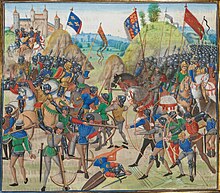| Gascon campaign of 1345 | |||||||||
|---|---|---|---|---|---|---|---|---|---|
| Part of the Edwardian Phase of the Hundred Years' War | |||||||||
 A battle between French and English armies, as imagined by a contemporary chronicler | |||||||||
| |||||||||
| Belligerents | |||||||||
|
|
| ||||||||
| Commanders and leaders | |||||||||
|
|
| ||||||||
| Strength | |||||||||
| Under 8,000 at any time | Up to 20,000 | ||||||||
| Casualties and losses | |||||||||
| Light | Very heavy | ||||||||
The Gascon campaign of 1345 was conducted by Henry, Earl of Derby, as part of the Hundred Years' War. The whirlwind campaign took place between August and November 1345 in Gascony, an English-controlled territory in south-west France. Derby, commanding an Anglo-Gascon force, oversaw the first successful English land campaign of the war. He twice defeated large French armies in battle, taking many noble and knightly prisoners. They were ransomed by their captors, greatly enriching Derby and his soldiers in the process. Following this campaign, morale and prestige swung England's way in the border region between English-occupied Gascony and French-ruled territory, providing an influx of taxes and recruits for the English armies. As a result, France's ability to raise tax money and troops from the region was much reduced.
Ralph, Earl of Stafford, had sailed for Gascony in February 1345 with an advance force and, following conventional practice, laid siege to two French strongholds. Derby arrived in August and immediately concentrated available Anglo-Gascon forces and headed directly for the largest French force, which was gathering at Bergerac, 60 miles (97 km) east of Bordeaux. Bergerac had good river supply links to Bordeaux and would provide a suitable forward base from which to carry the war to the French. He decisively defeated the French there, before moving to besiege the provincial capital of Périgueux. By this time the French had diverted their main effort to the south west, under the overall command of John, Duke of Normandy, the son and heir apparent of King Philip VI of France. Unable to take Périgueux, and threatened by John's much larger force, Derby left garrisons blockading it and withdrew. One garrison, at Auberoche, was besieged by the French. Derby advanced with a small force, launched a surprise attack against the much larger French army and won another decisive victory.
The French army started to disintegrate: men were unpaid, even unfed; there was a lack of fodder for the horses; desertion was rife; and troops were selling their equipment. John lost heart on hearing of the defeat at Auberoche. The French abandoned all of their ongoing sieges of other Anglo-Gascon garrisons and retreated to Angoulême, where John disbanded his army, possibly because the French had run out of money. Derby moved back to the Garonne valley, captured the strong and well garrisoned town of La Réole, all of the French outposts downstream of it, and other strong French positions in the area. In November Derby paid off his army and overwintered in La Réole. Various small Anglo-Gascon groups maintained the pressure on the French, capturing several significant fortified places between December 1345 and March 1346.